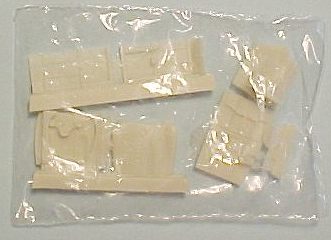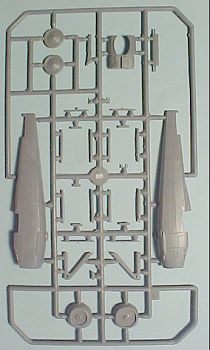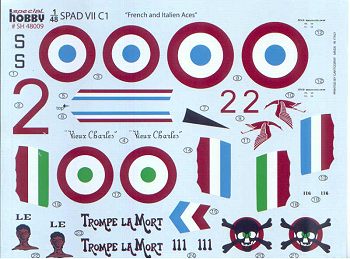
|
KIT: |
Special Hobby 1/48 Spad VII C.1 |
|
KIT # |
? |
|
PRICE: |
$29.95 |
|
DECALS: |
Three Aircraft |
|
REVIEWER: |
|
|
NOTES: |
Short run with resin parts |

|
HISTORY |
The SPAD VII C.1 was the first French fighter powered by an in-line engine. Heavier than the lightly-loaded, rotary-powered Nieuport series, it depended on speed and maneuverability in the vertical plane rather than the close-in high-g maneuvering of the rotary-powered fighters.
The Spad VII first appeared in the Spring of 1916, powered by a 150 h.p. Hispano-Suiza V-8, and armed with a single Vickers machine gun utilizing an interrupter gear designed by Louis Bechereau, who designed the engine. Difficulties were encountered in supplying useful radiators that could maintain engine temperatures, and only some 140 were produced by the end of the year. The Spad VII finally began to appear in appreciable numbers in 1917, when it was powered by an upgraded 180 h.p. Hispano-Suiza, which made it one of the fastest scouts on the Western Front and a very worthy opponent of the contemporary Albatros D.III. In addition to the 30 French Escadrilles that were eventually equipped with the fighter, the Foyal Flying Corps also obtained several hundred which equipped some ten squadrons. The aircraft was also built under license in Russia by Duks, with approximately 100 eventually seeing service on the eastern front. In Italy, Aeronautica Macchi undertook license production in early 1917 and the SPAD VII was one of the major types operated by the Italian air force until the end of the war; Francesco Baracca favored it over the later SPAD XIII for its superior handling, and scored the majority of his 29 victories while using the type.
Even after the appearance of the more powerful and more heavily-armed SPAD XIII, the SPAD VII remained in production until late 1917, and was still in squadron service as late as the German Spring Offensive of 1918, though it was completely gone from the Western Front by that summer.
Post-war, the SPAD VII equipped several air forces, including Belgium, Holland, Czechoslovakia, Italy, Japan and Finland.
|
THE KIT |
 |
 |
 |
I think the SPAD series of fighters are either my favorite World War I airplanes, or tied in a dead heat with the Albatros series. This likely goes back to the fact that when I was very young, my father was friends with an older man in our neighborhood who had actually flown Spads in World War I, and I loved looking at his photographs. I also built the old Hawk (now Testors) Spad model, of which I was too young at the time to know it was "too difficult" for me to do.
There have only been two other kits of the SPAD VII available, one being a resin kit from JMGT in France that is still available and makes up into a very nice-looking model if you are careful not to snap the very thin and very brittle wings (I speak from experience), and one done several years ago by Blue Max which is long out of production and a real "find" if you can run across it.
 This SPAD VII by the
Czech firm Special Hobby comes on two sprues of grey plastic, with a resin
cockpit and a decal sheet that allows the modeler to create SPAD VIIs flown by
Georges Guynemer and Maxime Lenoir of the French Air Force, and one flown by
Capitano fulco Ruffo di Calabria of the Italian Air Force. The red in the
insignias seems a bit dark to me. Fortunately, Aeromaster has just re-released
their SPAD VII decal sheet
, which provides several different aircraft flown by well-known pilots.
This SPAD VII by the
Czech firm Special Hobby comes on two sprues of grey plastic, with a resin
cockpit and a decal sheet that allows the modeler to create SPAD VIIs flown by
Georges Guynemer and Maxime Lenoir of the French Air Force, and one flown by
Capitano fulco Ruffo di Calabria of the Italian Air Force. The red in the
insignias seems a bit dark to me. Fortunately, Aeromaster has just re-released
their SPAD VII decal sheet
, which provides several different aircraft flown by well-known pilots.
The injection-molded parts of this kit are very well-done, with a muted and more accurate fabric effect overall, with the wings and tail all commendably thin. The resin cockpit is nicely-detailed with some photo-etch for additional details and the seatbelts.
I can report that within the two days since this kit arrived at Le Chateau du Chat, it now sits assembled at the point of being ready for paint. By careful removal of the parts from the sprue trees, and careful test-fitting and assembly, it came together without the use of any putty anywhere, or any need for Mr. Surfacer. This is one of the best limited-run injection-molded WW1 kits I have yet run across; it compares favorably with recent releases by Eduard in the genre.
|
CONCLUSIONS |
This is a well-designed, well-produced kit of an interesting and historically-significant airplane. The design of the kit is so good that it can even be recommended to a modeler who has yet to try a World War I model, though the rigging will be more difficult than that of an Albatros or a Nieuport. I am sure there will be more than one of these sitting in the Spad section of my World War I shelves. Highly recommended as good value for money spent.
Kit supplied courtesy of my wallet.
If you would like your product reviewed fairly and quickly by a site that has well over 150,000 visitors a month, please contact me or see other details in the Note to Contributors.
Back to the Previews Index Page